We all know that updating and refreshing pages on our website is an important part of an ongoing SEO process. It is an expensive investment with time and money put into keyword research, creating content briefs, editing, formatting, and publishing.
How do we make sure this content optimization happens in a process-driven manner, maximizing the return on these content investments?
We’ve launched a new feature in SEOTesting called Page Actions that will help you:
- Assign pages that need updating to writers
- Run tests on the content optimizations
- Set next action dates on URLs, so pages are never forgotten
But what have we all been doing up until now?
A Reliance on Spreadsheets
I am sure we have all done something like this:
1. Export URLs and data from Search Console
2. Add a column to track the date it was last refreshed
3. Add a column to track the date it should next be refreshed
4. Add a column on who is assigned to do the next update
5. Add a column full of notes that end up being hard to read
Executing on these dates involves remembering to check the spreadsheet and scheduling items in whatever task management system is used such as Trello, Todoist or ClickUp.
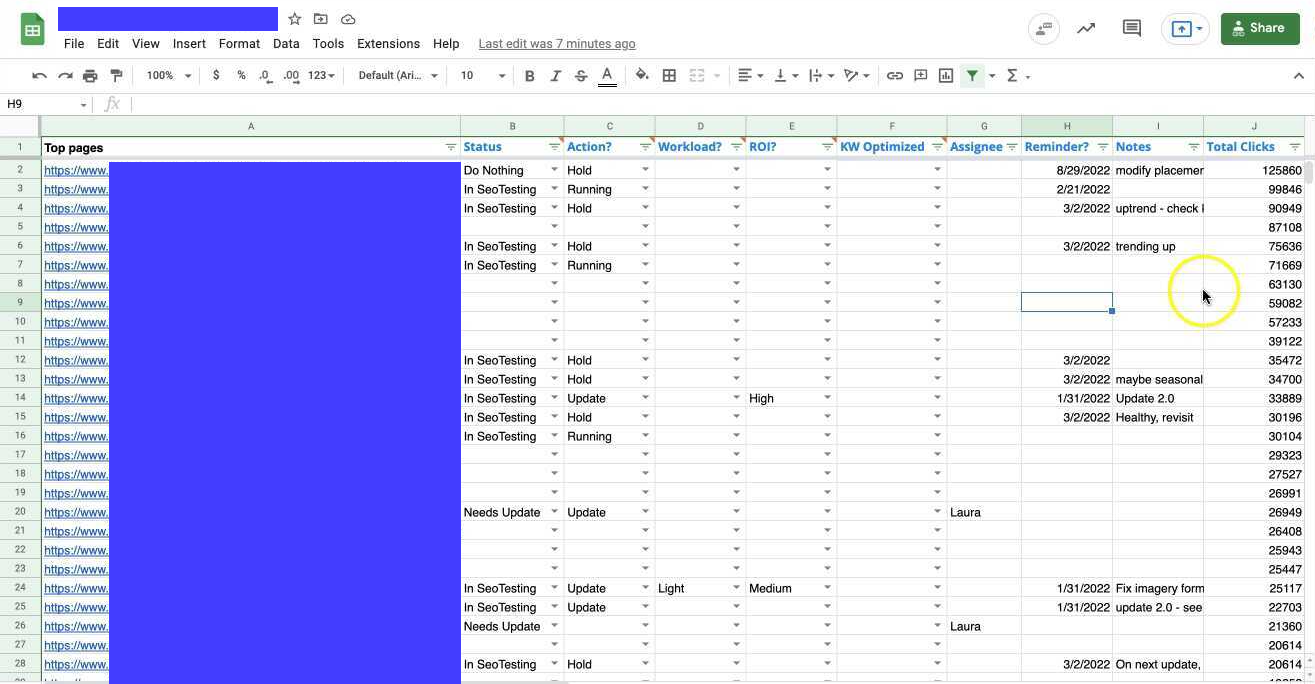
This leads to fragmented data and systems. Having these SEO-related tasks in another project management system, means the context, queries, and data are detached from the main data source.
Customers of SEOTesting have been suggesting there must be a better, more joined-up way! A better way to manage your existing content, and understand how your content is performing.
The New Way – Introducing Page Actions in SEOTesting
Within SEOTesting you can now set a next action status on each URL discovered via Google Search Console. These new statuses are called Page Actions.
Unlike 3rd party tools that only provide estimates, Google Search Console and SEOTesting.com provide actual real data about your website. As soon as pages are first displayed in the search results, or your content starts to rank for new queries, you can take action on them.
Page Actions in SEOTesting will enable you to build up an SEO process and strategy for ongoing content management and optimization.
A page can have 1 of 5 statuses:
- Update
- Check
- Testing
- Review
- Do Nothing
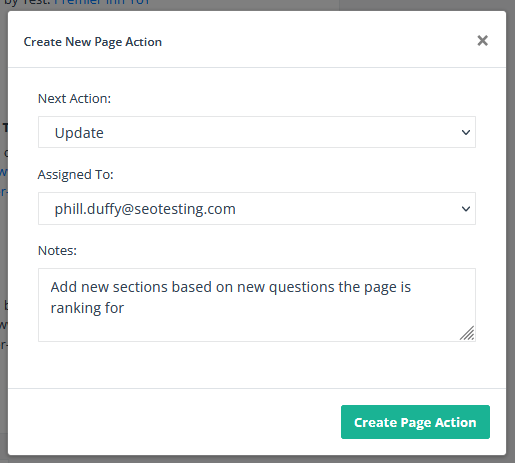
Along with a status field, it is assigned to someone with a notes field for extra information (or a link, for example to a Trello task or Google Doc).
How these statuses flow from one to another is not fixed within the tool, so you can build and document the process how you like. This is an example of how we have been using it at SEOTesting.
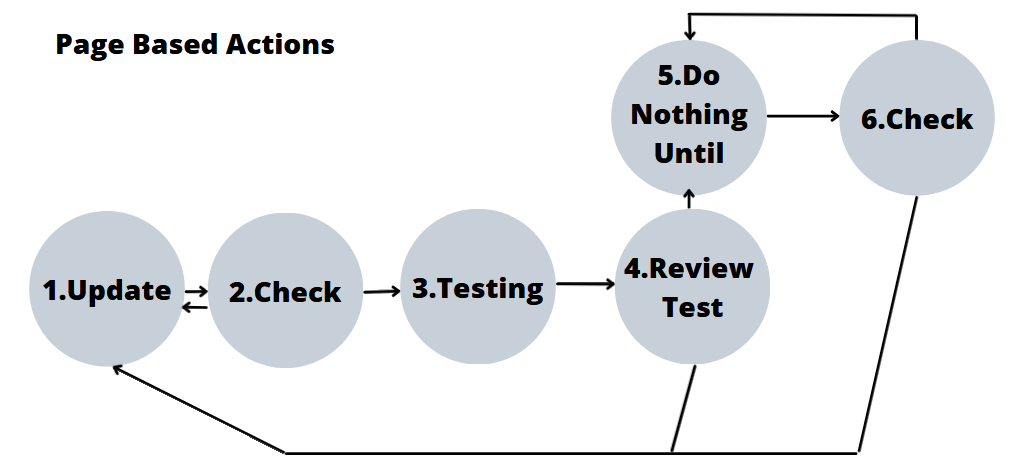
This type of process is most useful for a team that works together on content optimization.
Someone in the role of SEO initially selects a page and starts the process off.
To walk through how this process could work let’s set up a couple of personas:
Sarah – Head of SEOJames – Content Writer
1. Update
Sarah picks a page that hasn’t been refreshed for a while and so could do with going through a content optimization process.
She sets the Page Status to Update, along with it being assigned to James and any notes around what to do [see how to optimize content]
James gets an email with information about the Update task being set for them, and a task added to their SEOTesting task list.
2. Check
Upon James doing the update and content optimizations, he would set the Page Action status to Check and assign it back to Sarah.
Sarah would get an email alert to know the page is ready to check.
At this point, upon having looked it over, Sarah can revert it back to James by setting the status back to Update with further instructions, or set up an SEO test for the page which would automatically set the Page Action status to Testing.
3. Testing
Pleased with the content update, Sarah create a time-based SEO test for the page that has been updated so performance can be tracked.
Creating a time-based test on a specific URL will automatically set the Page Action status to ‘Testing’
4. Review Test
Upon the test period finishing, the Page Action status is set to ‘Review Test’
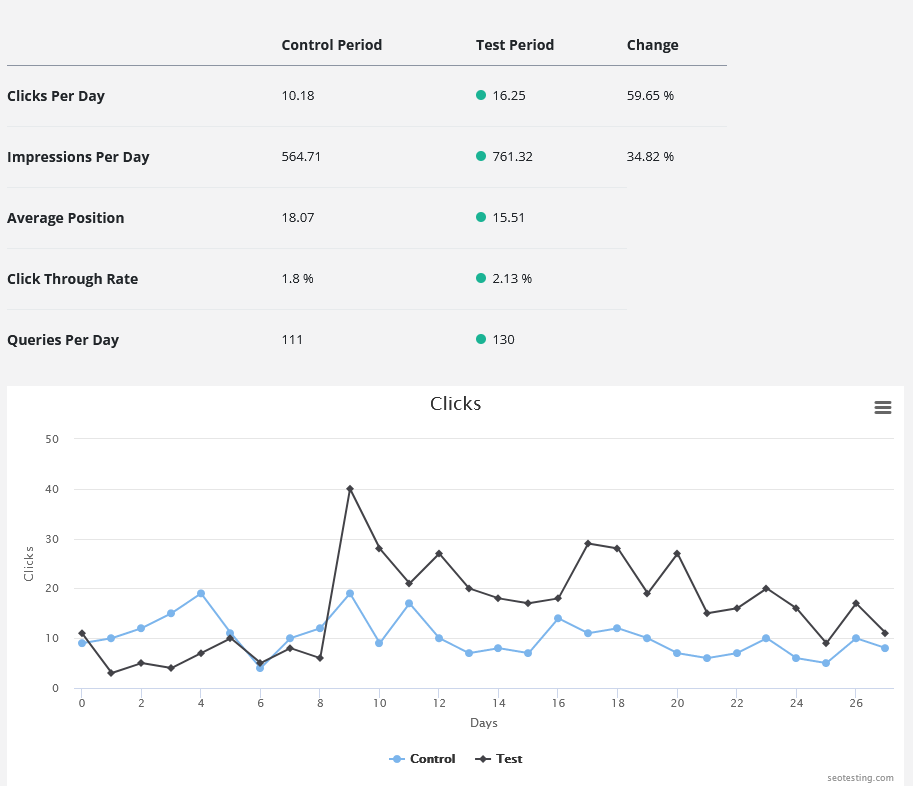
Sarah visits the test results page and analyses how the content optimizations have affected the page.
In our workflow example, Sarah now has 2 choices.
If the SEO test results are negative in terms of a decrease in clicks or click-through rate, it’s likely that Sarah will either want further optimizations or potentially revert to the previous version.
This can be achieved by setting the Page Action status back to Update with notes on what is to be done – and so the Update/Check/Test process can start again.
Even if the test results are positive, as head of SEO Sarah may decide to immediately optimize or update further based on new queries or the page is ranking for straight away.
So the Update/Check/Test process may still continue straight after a successful optimization and test result.
5. Do Nothing Until
Assuming the update has been positive it is more likely, especially for a big site with lots of content to refresh and optimize, that Sarah will set the page status set to ‘Do Nothing Until’ with a date being set.
This will effectively pause the workflow for this page.
The workflow will restart when the ‘Do Nothing Until’ date is reached.
At this date, the Page Action status will change to Check and be assigned to Sarah for her to take a look. Sarah can decide whether now is the right time to go through another content update process.
If it’s not the right time the article can be set back to ‘Do Nothing Until’ again, with another date set in the future.
This process of setting a ‘Do Nothing Until’ date means an article doesn’t get forgotten as part of an ongoing content optimization process.

A picture of what’s been done to a page and by whom
Page Actions are useful for seeing the immediate next action on a page, but they also build up a historical picture of what has been done over a period of time.
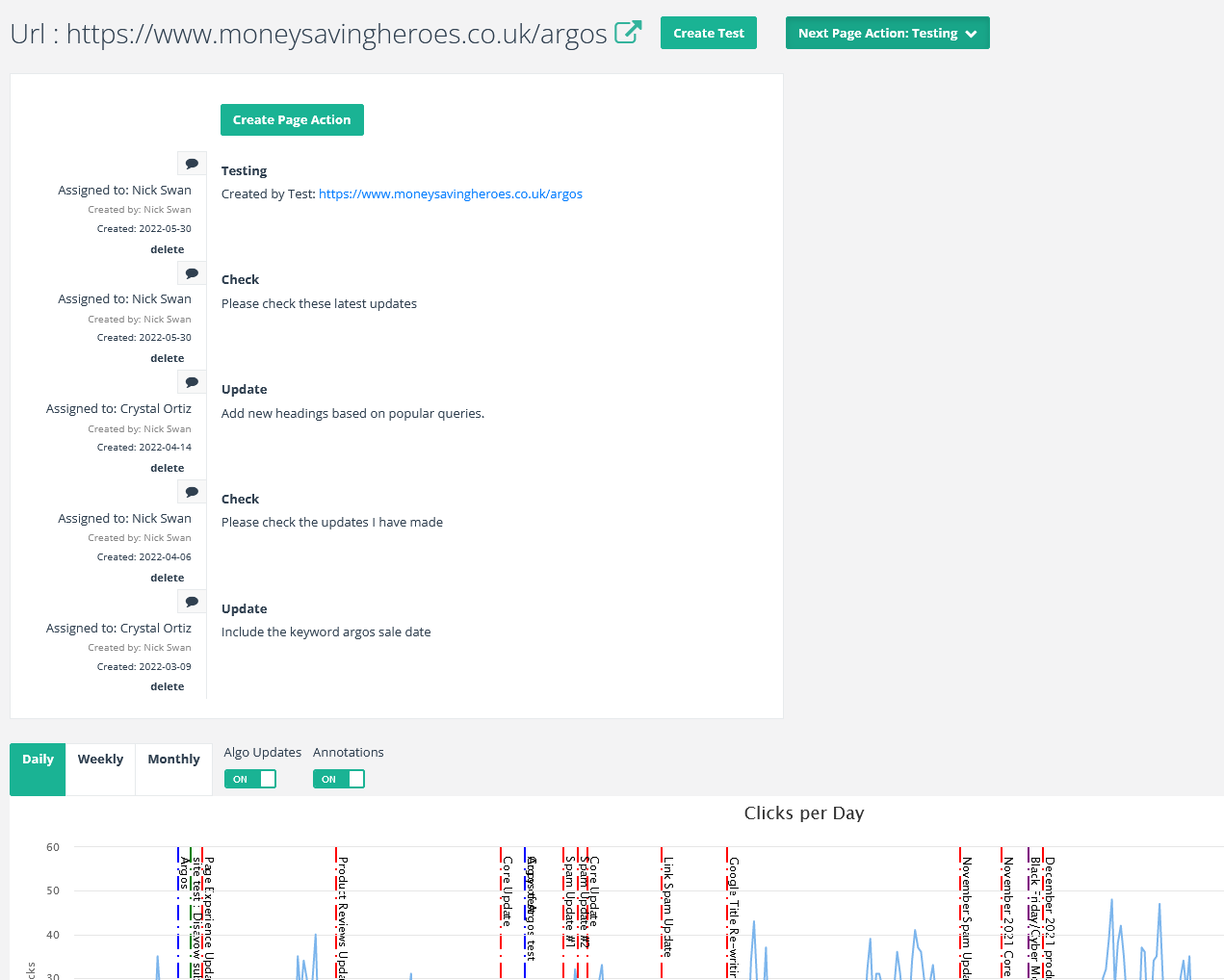
As team members come and go, the history and knowledge of what has been done to a page along with how the changes affect performance are stored.
How to kick start a content optimization process
Start with All Pages
If you are starting with Page Actions for the first time and looking for pages to begin with, the All Pages report in SEOTesting is a good place.
All Pages lists all the URLs on your site with the highest number of clicks first.
Start at the top of the report, select content-based pages, and kick them off with an Update Page Action.
The All Pages report has a column for the Next Action, so you can easily see the state of each URL on your site.
You can also use the Page Status filter, so you can view URLs that are in a particular stage of the optimization process.
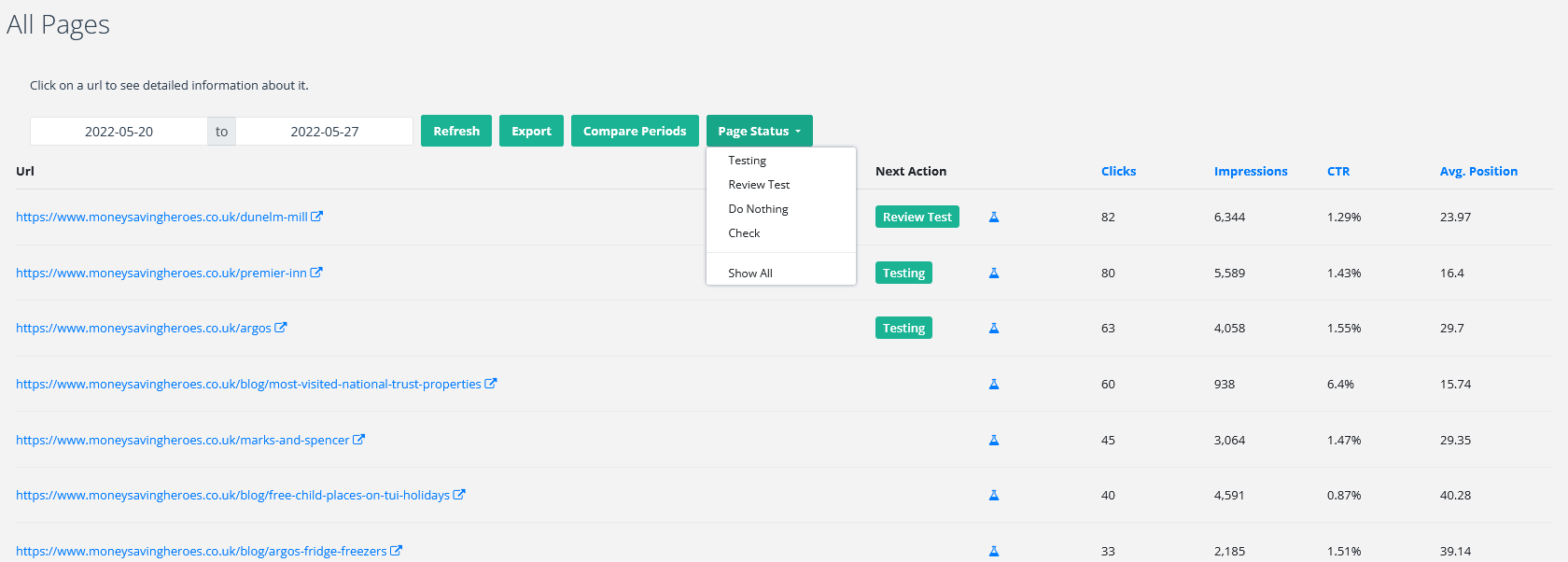
This is useful to see all the pages currently being updated, in testing, and so on.
New pages
As new pages first appear within the Google search results, SEOTesting users get a daily email notification. These notifications are often for recently published pages.
While you wouldn’t usually start an optimization process as soon as a page starts to rank, as these new URLs appear in the search results you can give them a Page Action status of ‘Do Nothing Until’ and set the date to 3 months time.
This makes sure pages are placed into the optimization process and not forgotten about.
In 3 months time, you will have a larger number of queries to work with when it comes to updating content and adding new sections.
Remembering to revisit and refresh content is one of the problems with an ongoing content management and optimization process.
By adding each new content URL into the Page Action process as soon as it is in Google’s search results you will make sure no content gets forgotten about and is optimized in an appropriate time frame.
How to optimize content
Optimizing content based on search queries has a page all by itself, but here is a quick summary:
Use Google Search Console data
Whether you use Google Search Console directly, or use the Page Details view in SEOTesting, using first-party data to optimize your pages is the best place to start.
You will see queries your page is already ranking for. If they are queries that are missing from the page (SEOTesting will highlight this for you), and it makes sense to, add them into your existing content.
Use Google
Never forget that Google itself is a great SEO tool.
Run searches for the queries you are targeting and check the ‘People Also Ask’ sections, search suggestions, and search auto-complete for ideas on new content sections for your page.
Use third-party tools
You can do competitor research using tools such as ahrefs and SEMRush.
These allow you to enter a URL of a page on a competitor’s site and see the queries it estimates the page is ranking for.
These tools make use of scraped search results and traffic estimates, so the estimated monthly search volumes are considered third-party and not always that accurate for long tail keywords. But they should be part of your optimization strategy.


